Successful trailer towing is as much preparation as it is execution. You can be the most veteran over-the-road truck driver, but if your rig isn’t up to the task, you’re not going anywhere. Thankfully, there are a few key areas that if checked (or even upgraded) will ensure many years and thousands of miles of happy trailering for both you and your truck.
Cooling Is Key
Arguably the most important aspect of successful trailer towing is keeping the tow vehicle cool. Heat is a killer, and if the engine or drivetrain is allowed to overheat, one could quickly find himself watching traffic pass from the side of the road. While the factory cooling package might be sufficient enough to cool a stock truck, once the power starts getting turned up, heat builds fast.
Before heading out on the road, it’s wise to take a peak at your truck’s coolant level and condition. Is it bright and clear or more similar to toxic sludge? If the latter is the case, then it’s time for a full cooling system flush and fill. Flushing the cooling system will dislodge any grime that may have built up in radiator passageways or water jackets, allowing for better flow, and a fresh fill of coolant will restore the system to its full cooling capacity. Still not enough to keep your tow rig cool on those long grades? Then an upgraded aluminum radiator with greater cooling capacity might be just what the doctor ordered.
Even more susceptible to the effects of heat than the engine is your truck’s slushbox. Overheated fluid is the number one cause of death for automatic transmissions. New trucks are rolling out of the factory with ever-larger transmission coolers to meet the needs of todays higher-power-output engines and skyrocketing towing capacities, but that doesn’t mean they can’t be improved upon. Old and new pickups alike can benefit from the improved cooling provided by an aftermarket transmission fluid cooler. Adding a simple auxiliary cooler inline with the factory unit can nearly double the life of transmission fluid, keeping your gearbox happy and healthy for a long time. Also helpful are aftermarket aluminum pans. Their added fluid capacity and finned heat-sink design provide additional cooling as well.
Knowledge Is Power
Keeping a watchful eye on your truck’s vitals can help you spot potential issues before it’s too late. This is especially important when towing with a modified diesel, as parameters such as exhaust gas temperature should be monitored closely to prevent damage to critical engine parts like the turbocharger. A proper array of gauges will allow drivers to monitor EGT but also coolant and transmission temperature, boost, and—on newer, more heavily modified trucks—rail pressure. Gauge options range from the traditional, pillar-mounted gauge pods to newer, digital touchscreen displays. As a basic guideline, we start to take notice when the engine temperature nears 210 degrees, 200 for the transmission, and 1,200 EGT.
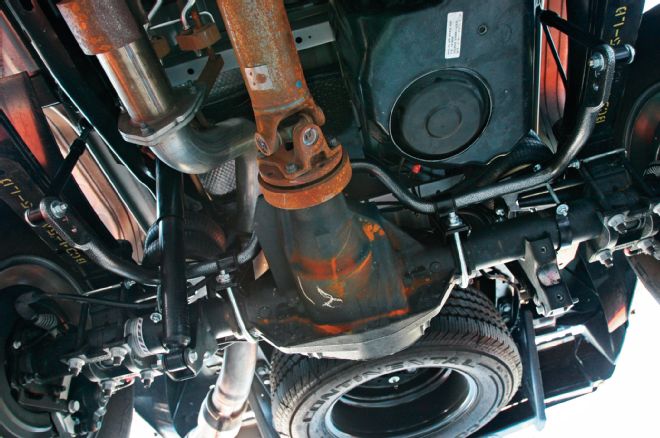
| A heavy-duty rear sway bar for your tow rig can be a valuable aid when towing a large trailer.
Keeping the tow vehicle planted and level will help keep the trailer following straight.
Preventative Maintenance
The only thing worse than being stranded on the side of the road is being there because of something that was preventable. Before you head out on the open road, it’s imperative that all of your truck’s regular maintenance is up to date. Check that your oil level is full and not in need of being changed, be sure the fuel filters are clean and any water is drained from the separator (if equipped), and make sure the air filter is clean and the air box is clear of leaves and other debris. A tire blow-out can ruin your day and your body panels, so be sure all four tires are properly inflated, lug nuts are torqued to spec, and your tire tread is in good shape. And don’t forget to check the spare tire as well.
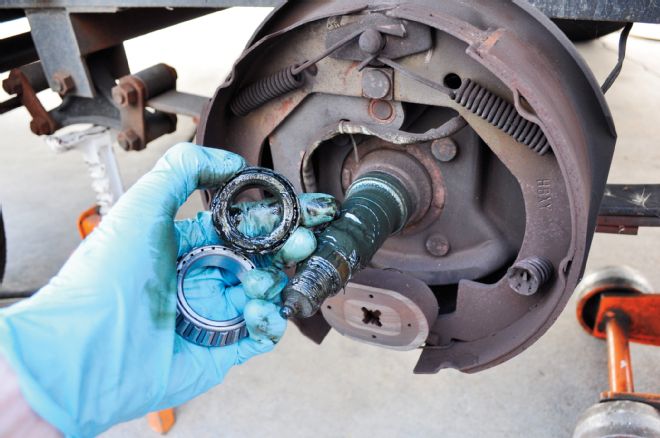
| Trailer wheel bearings and electric brakes, like those seen here, should be checked often
for worn or damaged parts. Bearing preload should be checked before every trip.
Pre-Trip Trailer Checklist
- Trailers need love, too. Once your tow vehicle is in order, a quick rundown of the trailer in tow will help ensure nothing major was overlooked.
- Check tires for proper inflation
- Make sure all wheel lug nuts are torqued to spec
- Verify that the hitch ball mount is secure and the proper ball is installed
- Visually verify that all lighting is functional
- Be sure the safety chains are in place and properly attached
- Double-check that all cargo is securely fastened to the trailer
- Ensure the trailer jack is fully raised
- Verify the trailer brakes are plugged in and functional
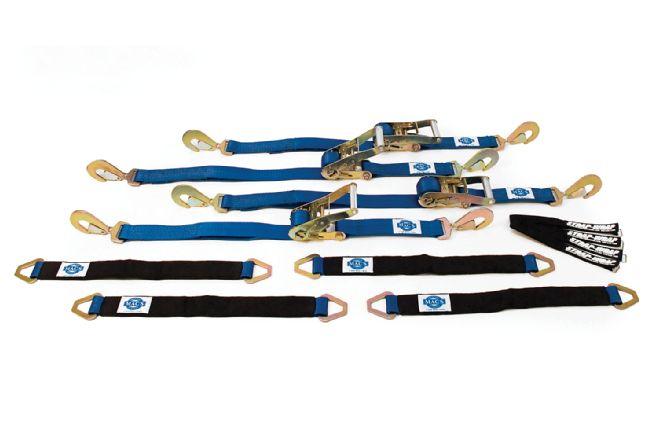
| Quality tie downs are essential for making
sure the load you’re hauling stays firmly
attached to the trailer—even if you hit
some rough patches of road or need to
make an evasive
maneuver.
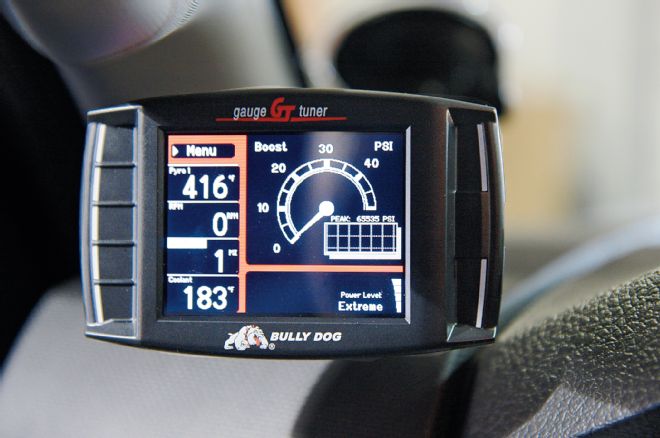
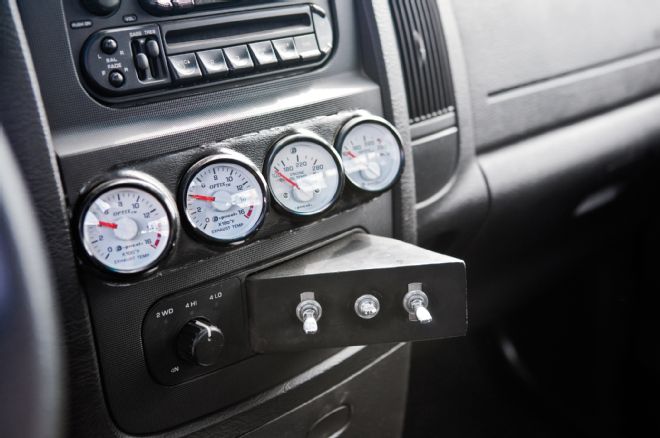
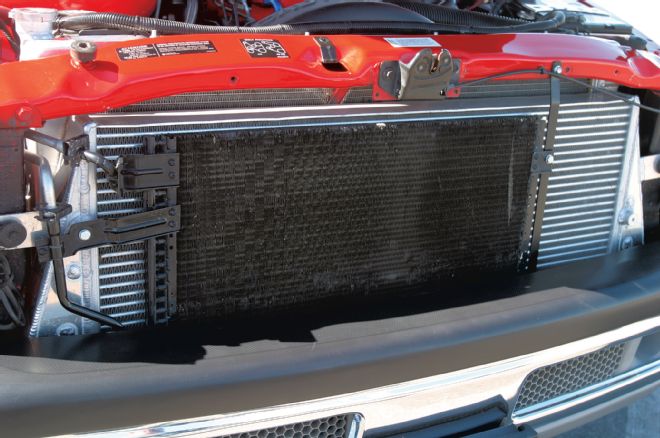
 | A heavy-duty rear sway bar for your tow rig can be a valuable aid when towing a large trailer.
Keeping the tow vehicle planted and level will help keep the trailer following straight.
Preventative Maintenance
The only thing worse than being stranded on the side of the road is being there because of something that was preventable. Before you head out on the open road, it’s imperative that all of your truck’s regular maintenance is up to date. Check that your oil level is full and not in need of being changed, be sure the fuel filters are clean and any water is drained from the separator (if equipped), and make sure the air filter is clean and the air box is clear of leaves and other debris. A tire blow-out can ruin your day and your body panels, so be sure all four tires are properly inflated, lug nuts are torqued to spec, and your tire tread is in good shape. And don’t forget to check the spare tire as well.
| A heavy-duty rear sway bar for your tow rig can be a valuable aid when towing a large trailer.
Keeping the tow vehicle planted and level will help keep the trailer following straight.
Preventative Maintenance
The only thing worse than being stranded on the side of the road is being there because of something that was preventable. Before you head out on the open road, it’s imperative that all of your truck’s regular maintenance is up to date. Check that your oil level is full and not in need of being changed, be sure the fuel filters are clean and any water is drained from the separator (if equipped), and make sure the air filter is clean and the air box is clear of leaves and other debris. A tire blow-out can ruin your day and your body panels, so be sure all four tires are properly inflated, lug nuts are torqued to spec, and your tire tread is in good shape. And don’t forget to check the spare tire as well.
 | Trailer wheel bearings and electric brakes, like those seen here, should be checked often
for worn or damaged parts. Bearing preload should be checked before every trip.
Pre-Trip Trailer Checklist
| Trailer wheel bearings and electric brakes, like those seen here, should be checked often
for worn or damaged parts. Bearing preload should be checked before every trip.
Pre-Trip Trailer Checklist
 | Quality tie downs are essential for making
sure the load you’re hauling stays firmly
attached to the trailer—even if you hit
some rough patches of road or need to
make an evasive
maneuver.
| Quality tie downs are essential for making
sure the load you’re hauling stays firmly
attached to the trailer—even if you hit
some rough patches of road or need to
make an evasive
maneuver.